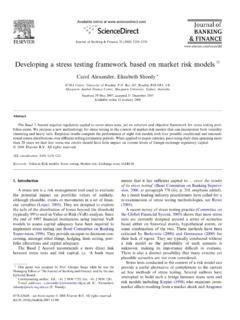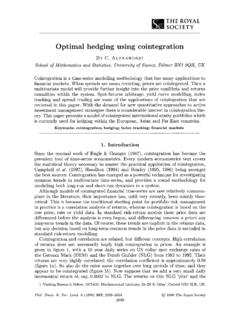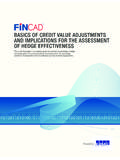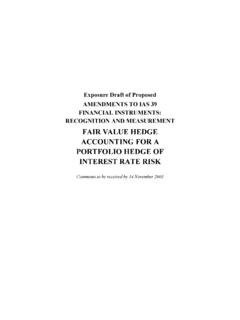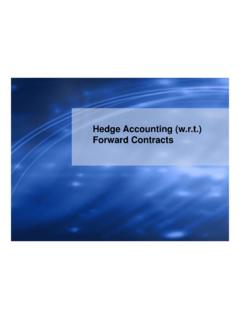Transcription of Effectiveness of Minimum-Variance Hedging - …
1 12/13/06 7:30 PM Page 1. Effectiveness of Minimum-Variance Hedging The impact of electronic trading and exchange-traded funds. Carol Alexander and Andreza Barbosa he debate on econometric models for estimating T the Minimum-Variance futures hedge ratio has run for many years. Hedging commodities is an interesting econometric problem because carrying costs are difficult to predict, and the basis can be high and variable, but stock indexes generally have much lower basis risk. Nevertheless econometric models for min- imum- variance (MV) Hedging of stock indexes continue to be the focus of a huge amount of empirical research.
2 We show that minimum variance Hedging only pro- vides an out-of-sample Hedging performance that is supe- rior to that of the na ve futures hedge in less developed markets, which have no active trading of ETFs or advanced electronic communications networks. Moreover, even when minimum variance Hedging does out perform a na ve hedge we find no evidence that complex econo- metric models, including time varying conditional covari- ances and error correction, can improve on the simple ordinary least squares hedge ratio. A recent strand of the literature on market microstruc- ture that relates to the impact of electronic trading on bid-ask spreads.
3 Electronic trading reduces both human CAROL ALEXANDER errors and, as smaller lot sizes become economically fea- is the chair of risk sible, market , given the discipline required to management and director of research at the ICMA commit trading rules to execution algorithms, it increases Centre of the University objectivity. Moreover, electronic trading increases liquidity of Reading in the because transaction costs are reduced. A recurrent proxy for transaction costs is the bid-ask spread, and several writers have tested the impact of elec- ANDREZA BARBOSA tronic trading on reducing this spread. Early studies in is a candidate at the ICMA Centre New Zealand (Blennerhasset and Bowman [1998]) and of the University Germany (Frino, McInish, and Toner [1998]), and on the of Reading.
4 Cross-listing of Bund contracts in Germany and England (Pirrong [1996]), report lower bid-ask spreads in WINTER 2007 THE JOURNAL OF PORTFOLIO MANAGEMENT 1. 12/13/06 7:30 PM Page 2. electronic trading systems. Yet Massib and Phelps [1994] cash market efficiency and reducing the no-arbitrage range argue that open outcry can offer greater liquidity than for the future about its fair value. electronic systems, and Shyy and Lee [1995] find that In the presence of high trading costs and costly infor- spreads are actually wider on electronic systems than on mation, we might see temporary divergence from the floor trading of the Bund futures contracts.
5 Equilibrium relation between spot and futures prices. But, More recently, Chordia, Roll, and Subrahmanyam as trading costs drop and spot-futures arbitrage is facili- [2001] analyze the characteristics of equity market tated by an ETF, the correlation between spot and futures spreads, depths, and trading activities. They observe a returns increases, and basis risk declines. downward trend in spreads and the opposite trend in depth Hence the development of both index ETFs and an and volume. They also find that bid-ask spreads respond advanced electronic trading networks may reduce the effi- asymmetrically to market movements, widening signifi- ciency of a Minimum-Variance hedge ratio compared to a cantly in downward markets but narrowing only margin- naive hedge ,which matches the short position in the future ally in up markets, and they also argue that excessive market exactly to the spot position.
6 We shall show that no signif- volatility can reduce rather than widen the bid-ask spread. icant gains can now be made from MV futures Hedging of Copeland, Lam, and Jones [2004] conclude that some major stock indexes, although MV Hedging may still screen trading does not improve the efficiency of FTSE, improve on a one-to-one hedge on less efficient exchanges. CAC, DAX, and KOSPI futures Fung et al. Furthermore, we show that on those exchanges [2005] argue that electronic trading on the Hang Seng where MV Hedging may still be more effective than a Composite Index attracts more informed traders to the one-to-one hedge , it is not possible to distinguish which futures market and increases information flow, in addi- econometric model most efficiently reduces the variance .
7 Tion to reducing the bid-ask spread. Finally, our results also support the growing evidence ( , Tse and Zabotina [2001], Aitken et al. [2004], and from Copeland and Zhu [2006]) that more sophisticated Gilbert and Rijken [2006] analyze FTSE 100 futures con- econometric models such as GARCH introduce too much tracts as that trading migrated from open outcry to elec- noise to provide cost-effective hedges. tronic trading in May et al. [2004] find wider The theoretical and empirical methodology in this spreads, while Tse and Zabotina [2004] and Gilbert and article extends previous research in two significant ways: Rijken [2006] find narrower spreads.
8 Thus conflicting claims on the advantages of elec- Lien [2005] proves that it is not appropriate to eval- tronic systems for reducing transaction costs and providing uate the Hedging performance of conditional variance effective liquidity, especially during highly volatile periods, minimization using the unconditional Effectiveness are frequent in academic a recent survey by measure of Ederington [1979],even though it is com- Burghart [2006] on global trends in trading volumes and monly used in most research on this subject. Since average bid-ask spreads provides a convincing argument performance is sample-specific (it depends on both that the growth of electronic trading systems since 1999 the estimation and the evaluation samples), we intro- has been the driving force behind dramatically increased duce a conditional measure of Hedging Effectiveness .
9 Trading volumes and huge reductions in bid-ask spreads We use this conditional Effectiveness measure to in the last six years. He shows that while average volatility- examine the evolution of Hedging efficiency over adjusted bid-ask spreads on several electronically traded many years, before and after the development of futures have steadily declined to between 60% and 90% electronic trading platforms. Our results are based on of their level in 1999, those on pit-traded contracts such an out-of-sample performance test on nearly 4,000. as soybeans and crude oil have not dropped at all. observations of most of the seven indexes, consid- While the effect of electronic trading on market erably larger than in any other published research.
10 Efficiency remains a point of academic debate, there is a consensus view that cash market efficiency is enhanced with introduction of an exchange-traded fund (ETF) or LITERATURE ON. iShare on the index. Ackert and Tian [2000, 2001], Minimum-Variance Hedging . Switzer,Varson, and Zghidi [2000], Chu and Hsieh [2002], and Kurov and Lasser [2002] argue that an ETF or iShare Johnson [1960] was the first to derive the number contract facilitates spot-futures arbitrage, thus enhancing of futures contracts necessary to hedge a certain spot posi- 2 Effectiveness OF Minimum-Variance Hedging WINTER 2007. 12/13/06 7:30 PM Page 3.
